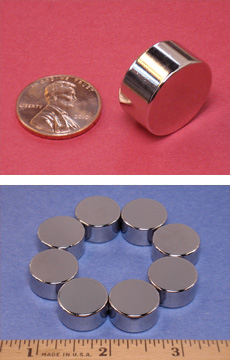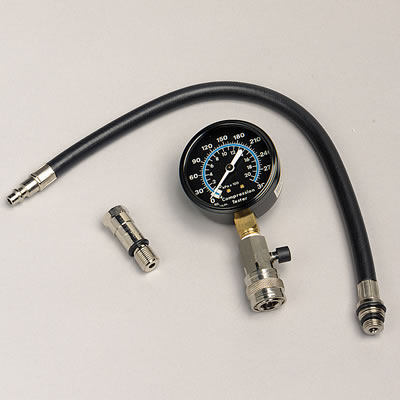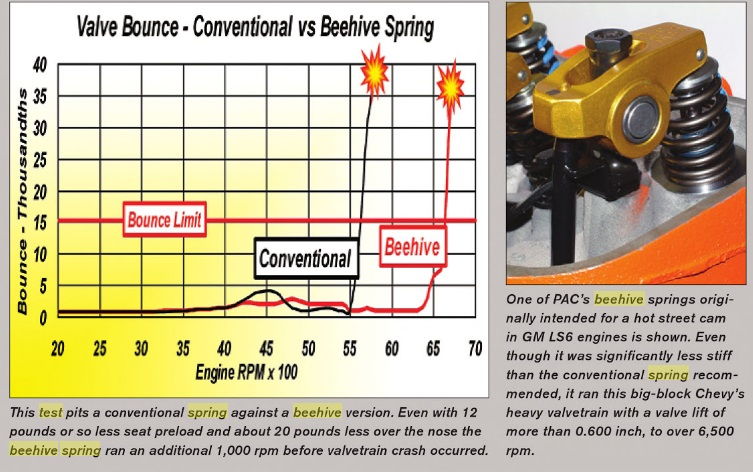allenc said:The valves on my 355 small block chevy engine , thats using older fuelie heads,and a dontov cam, that seems to be entering valve float at about 5800rpm-6000rpm, my older friend suggested upgrading to a set of "Z28 valve springs" and suggested the swap process could be done without removing the heads from the engine, whats the chances this will work out to my advantage?
https://sdparts.com/details/scoggin-dic ... ter/sd1005

many more modern oil formulations lack the correct additives for flat tappet lifters, so be very sure you check to see what oil your using and if its designed for flat tappet lifter applications
http://www.alexsparts.com/sbc-valve-spr ... -sb-chevy/
changing to newer valve springs to replace those that may be decades old, well,its a fairly common job that an experienced hobbyist can do in any garage or drive way, if you have some simple tools and know what your doing and how to check clearances.
I,ve seen remarkable improvements in the past when 30-40 year old valve springs on older , SBC ENGINE powered muscle cars were replaced with the newer .600 lift rated Z28 valve springs once they were carefully clearanced and set up at the correct installed height, older valve springs can easily loose 20% of there original listed load rate
Lots of guys have upgraded to those valve springs on older heads and had few issues, its usually a good upgrade over the stock springs, but keep in mind you could screw up the install and need to pull one or both heads if your not careful, and pay attention, during the swap procedure. BTW if the valve keepers seem to be stuck, thats very common and very easily cured, spray the keepers with carburetor cleaner or throttle body cleaner let sit for at least 3 minutes then drop a few drops of a good penetrating oil on the keepers then get out a deep well 5/8" socket with a 6" extension , center the socket over the valve stem and give it 3-5 good solid hard whacks in rapid succession on the end of the extension with a plastic mallet , then use a valve spring compressor to remove the locks,(btw place a large magnet like this on the compressor fork arms as it tends to grab the loose keepers)
YES YOU NEED TO SPEND THE $5 for this tool it constantly gets used
http://www.kjmagnetics.com/proddetail.asp?prod=DC6DIA

ceramic magnets are glass hard ,don,t drill or grind as they can shatter
http://www.harborfreight.com/soft-face- ... 69048.html

you might also consider new rockers , or even a new cam and lifters during the upgrade.
changing valve springs may solve your problem, but keep in mind thats not the only potential reason you might think the valves are "entering valve float" so check out the condition of the cam,lifters and rockers ETC, during the valve spring upgrade if you go that route and for sure check clearances.
valve spring dimensions and load rates, clearances and installed height vary between years, models,cylinder heads, and engine applications
a safe bet is that youll need to do some research and measuring before and after buying valve springs to get them correctly installed, failure to match the correct spring specs and clearances, load rates etc, usually leads to problems, and machine work on the heads , valve spring pockets, rocker studs and valve seals will be required on many performance upgrades
HAVING ACCESS TO A COMPRESSOR THAT PRODUCES 125 PsI air pressure
a valve spring compressor and the compression test tool hose to connect the compressor to the cylinder, and a marked damper with degrees marked so you can accurately bring the cylinder your changing the valve springs on each time to TDC, while you apply air pressure helps (don,t forget to place the engine in gear with the emergency brakes on each time so the engine won,t spin as you apply air pressure to cylinder)[/B]


If the valve springs are to be removed with the heads still on the car,
the last thing you want is too remove a valve spring and have the valve to drop into the cylinder,
if you use air the crank tends to want to spin the crank to BDC, youll want to verify TDC ,
and make sure the flywheels temporarily prevented from turning fro the TDC position,
Ive used both methods both work, Ive used both with zero issues,
If you use the compressor youll want to keep it at 120 psi and constantly feeding pressurized air to keep the valves held in place,
and theres a small chance the compressor pushes enough moisture to allow water to accumulate in the cylinders,
so be sure you spin the engine with the starter with the spark plugs removed several times before you re-install plugs.
if you use the rope, theres a very low chance that the rope will tangle and form a knot that makes removal difficult



WATCH VIDEO
some time spent reading links may save you a good deal of wasted effort or money or both
http://garage.grumpysperformance.co...-loads-and-installed-height.10709/#post-46662

GET THIS WRONG AND YOULL HAVE PROBLEMS

summit said:I have a small block Chevy in a ’66 Chevy II that seems to run pretty good but now I’m not so sure. It’s a 383 small block with a set of no-name aluminum heads, a Lunati hydraulic flat tappet Voodoo cam (227/233 degrees at 0.050 inches with 0.489/0.504-inch lift), a Performer RPM intake, and a 650 cfm Holley carburetor. The engine runs fine – doesn’t misfire or do anything funny – but I am concerned that it seems to stop pulling once the tach gets above 5,000 rpm. The ignition is an HEI with good Moroso wires and new spark plugs. The motor has been in the car for several years but about a year ago we changed to that Lunati Voodoo cam. It just seems like it lays down in high gear. Any ideas?
J.B.
Jeff Smith: One of the challenges of the whole hot rodding hobby/sport is that there are literally millions of combinations of parts from which to choose. With hundreds of companies making thousands of parts, the permutations of just cylinder heads, camshafts, intakes, and compression ratios becomes a blur of options. So it’s not surprising that you may have difficulties.
But I have some possible solutions.
You didn’t mention whether you were feeding the engine with a mechanical or electrical fuel pump. I’ll assume that the pump is probably mechanical. First thing to do is to check the fuel filter for obstructions. The fuel filter is often an afterthought and cheap, restrictive filters can reduce output from the pump. The pump may be capable of supplying fuel for low rpm and part throttle operation but at higher rpm, there is insufficient fuel pressure and volume due to a filter restriction, so start with that inspection first. Your 650 cfm Holley is big enough that it’s not really a restriction with regard to airflow.
The best way to check for adequate fuel flow is to install a fuel pressure gauge in between the pump and the carburetor and upstream of the fuel filter. This does not have to be an expensive Auto Meter gauge permanently mounted on the cowl – although this is a good idea. Instead, you could borrow or buy an inexpensive fuel pressure/vacuum gauge and plumb it into your fuel delivery system. Use a long length of rubber hose and place the gauge on the cowl where you can read it while driving. I’ve actually duct taped gauges to the lower portion of the windshield when doing diagnostic work like this. Next, run the car somewhere safe where you can make multiple passes past 5,000 rpm and monitor the gauge. Decent fuel pressure for a carburetor is 4 to 6 psi. It’s possible that at the higher engine speeds the pressure will begin to drop. If it falls below 3.5 psi, it’s possible that you’ve found the problem. Holley and several other companies make really good mechanical fuel pumps for a small-block. For example, Holley offers an 80 gallon per hour (gph) mechanical pump (PN 12-834) that will deliver more than enough fuel for our application. This pump should be able to easily supply 4.5 to perhaps 6 psi at WOT while supplying more than enough fuel volume.
If after checking fuel pressure you learn that your existing pump is working just fine, then we have another suggestion.
To be more accurate we would need more information on the valve springs and cylinder heads. But with an emphasis on the budget aspect, often these heads come with valve springs that are not up to the task of controlling the valves at high rpm. This is aggravated somewhat by the Lunati Voodoo camshaft. The Voodoo line offers great performance from a relatively short duration. Lunati accomplishes this by being fairly aggressive with the rate at which the intake and exhaust lobes open the valves. The Lunati description for this cam is “Makes unequaled power to 6,200 rpm with proper valve springs.” The key here is the connection to the valve springs.
Our experience with the Voodoo line underscores this load on the valve springs. You didn’t mention if you were running stock 1.5:1 ratio rockers. If so, that’s fine, but with 1.6:1 rockers, the additional ratio puts even greater forces on the springs because the rocker accelerates the valve even faster to achieve the greater lift. A combination of weak valve springs with a Voodoo cam and 1.6:1 roller rockers could easily cause the problem you are experiencing. Most guys would call this valve float. What they don’t tell you is how to fix this. That’s what we’re going to do.
The most accurate definition of valve float is when the spring loses control of the valve. When this happens, the first indication is when the intake valve bounces off the seat as it closes. This may not sound like a big deal, but the results will kill power. When the valve bounces off its seat, this occurs at the same time that the piston is rising in the bore and creating cylinder pressure. But when the valve bounces off the seat, it allows some of this pressure to escape. The reason the valve bounces is because the spring cannot exert enough load to keep the valve closed. When the valves bounce off the seat multiple times, the engine loses power and often can’t even achieve the rpm. This is classic valve float. Of course, the end result is a dramatic loss of power.
The most common fix for this problem is a stiffer valve spring, especially if the existing springs are on the weak side. What you should do is remove one spring and have it tested at a local machine shop. This will tell you the status of your springs. Stock replacement valve springs generally do not produce much more than about 90 to perhaps 100 pounds of seat load with an installed height of 1.750-inch. For a stock or mild performance cam, this is sufficient load. But with a performance camshaft like the Voodoo cam even Lunati’s base replacement spring is rated at only 98 pounds with at a 1.750-inch installed height and 286 pounds of force at 0.500-inch valve lift. My guess is that this spring will probably not work as well as something with a little more closed pressure, especially if the plans call for a 1.6:1 rocker. While a dual spring could do the job, this often places excessive load on the cam at peak lift. Instead, Lunati recommends using its new line of Signature Series Ovate Beehive springs. The complete valve spring and retainer kit (PN 74818K2) includes new beehive springs, retainers, and the necessary locks all under one part number.
This beehive spring offers a substantial increase in seat load from the previous spring’s 98 pounds at 1.750 to the beehive’s 130 pounds at a taller 1.800. Now that we know how valve float starts, perhaps you can see that a spring with essentially 30 percent more seat load will have a much better chance of keeping that intake valve closed at higher engine speeds. There are other added benefits to using a beehive spring but in the interest of brevity, we’ll save that discussion for another time. Changing over to the better valve springs will probably be the thing that will improve your engine’s performance and bring your small block back to life!
http://forum.grumpysperformance.com/viewtopic.php?f=52&t=1005
viewtopic.php?f=50&t=404&p=496&hilit=valve+spring+compressor#p496
viewtopic.php?f=50&t=903&p=12437&hilit=valve+spring+compressor#p12437
viewtopic.php?f=52&t=7716&p=26282&hilit=valve+spring+compressor#p26282
viewtopic.php?f=44&t=6548&p=38933&hilit=fuelie#p38933
viewtopic.php?f=44&t=6548&p=20798&hilit=fuelie#p20798
viewtopic.php?f=44&t=2099&p=17024&hilit=fuelie#p17024
viewtopic.php?f=52&t=181
viewtopic.php?f=52&t=401
viewtopic.php?f=52&t=2630
viewtopic.php?f=52&t=399
viewtopic.php?f=52&t=1376
viewtopic.php?f=52&t=528
viewtopic.php?f=52&t=9815&p=37266&hilit=rocker+studs#p37266
viewtopic.php?f=52&t=126&p=35548&hilit=rocker+studs#p35548
Last edited by a moderator:
